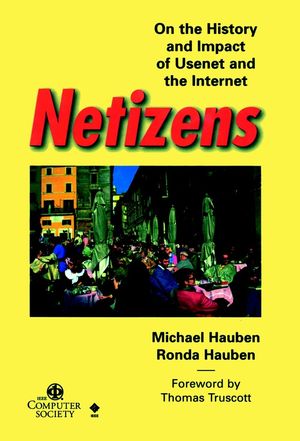Bill Stewart: Living Internet (2000)
Filed under living book | Tags: · computing, email, history of communications, history of computing, history of technology, internet, irc, mailing list, mud, usenet, web

An in-depth reference about the Internet.
The site was written from 1996 through 1999, first published on the web on January 7, 2000, and updated regularly. It has more than 700 pages, 2,000 intra-site links, and 2,000 external links to some of the world’s best online content about the Internet.
The site is authored by Bill Stewart who has used the Internet since 1988, and first appreciated the power of the medium during the Tiananmen Square rebellion in China in 1989, when he saw how the net kept Chinese communities around the world in touch with the events through email and newsgroups, bypassing all government censorship.
View online (HTML)
Comment (0)Michael Hauben, Ronda Hauben: Netizens: On The History And Impact Of Usenet And The Internet (1996)
Filed under book | Tags: · arpanet, community, computing, history of communications, history of computing, history of technology, internet, media history, netizens, unix, usenet, web

Netizens, one of the first books detailing the Internet, looks at the creation and development of this participatory global computer network. The authors conducted online research to find out what makes the Internet “tick”. This research results in an informative examination of the pioneering vision and actions that have helped make the Net possible. The book is a detailed description of the Net’s construction and a step-by-step view of the past, present, and future of the Internet, the Usenet and the WWW.
The book gives you the needed perspective to understand how the Net can impact the present and the turbulent future. These questions are answered: What is the vision that inspired or guided these people at each step? What was the technical or social problem or need that they were trying to solve? What can be done to help nourish the future extension and development of the Net? How can the Net be made available to a broader set of people?
With foreword by Tom Truscott
A print edition was published by the IEEE Computer Society Press, later distributed by John Wiley
ISBN 0-8186-7706-6
authors
publisher
google books
View online (HTML)
Comment (0)Patrice Flichy: The Internet Imaginaire (2007)
Filed under book | Tags: · 1990s, arpanet, computing, cyberpunk, cyberspace, freenet, history of communications, history of computing, history of technology, internet, networks, technology, usenet, utopia, virtual communities, virtual reality, web, wired

In The Internet Imaginaire, sociologist Patrice Flichy examines the collective vision that shaped the emergence of the Internet—the social imagination that envisioned a technological utopia in the birth of a new technology. By examining in detail the discourses surrounding the development of the Internet in the United States in the 1990s (and considering them an integral part of that development), Flichy shows how an entire society began a new technological era. The metaphorical “information superhighway” became a technical utopia that informed a technological program. The Internet imaginaire, Flichy argues, led software designers, businesses, politicians, and individuals to adopt this one technology instead of another.
Flichy draws on writings by experts—paying particular attention to the gurus of Wired magazine, but also citing articles in Time, Newsweek, and Business Week—from 1991 to 1995. He describes two main domains of the technical imaginaire: the utopias (and ideologies) associated with the development of technical devices and the depictions of an imaginary digital society. He analyzes the founding myths of cyberculture—the representations of technical systems expressing the dreams and experiments of designers and promoters that developed around information highways, the Internet, Bulletin Board systems, and virtual reality. And he offers a treatise on “the virtual society imaginaire,” discussing visionaries from Teilhard de Chardin to William Gibson, the body and the virtual, cyberdemocracy and the end of politics, and the new economy of the immaterial.
Publisher MIT Press, 2007
ISBN 0262062615, 9780262062619
255 pages
PDF (updated on 2012-7-25)
Comment (1)
